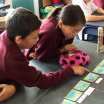Build whanaungatanga
Partner with ākonga and their whānau so you can understand and respond to the learner’s learning needs.
On this page:
On this page:
Current page section: Build whanaungatanga
Go to top of current page: Build whanaungatanga
Go to top of current page: Build whanaungatanga
Go to top of current page: Build whanaungatanga
Promote and protect languages and cultures
Promote and protect languages and cultures
The languages and symbols of children’s own and other cultures are promoted and protected.
Ko te whakatipuranga tēnei o te reo. Mā roto i tēnei ka tipu te mana tangata me te oranga nui.
Connect with culturally sustaining frameworks
Connect with culturally sustaining frameworks
For example use dimensions from the Māori health model, Te Whare Tapa Whā
Taha Whānau - family, people and relationships
- whānau, friends, iwi and hapū
- cultural, religious, social and recreational connections
- professionals working with the family
Taha Wairua - spiritual well being or life force
- spiritually strengthening aspects for example faith, being in nature, creative activities and meditation
- special interests
- hopes and priorities for ākonga and whānau
Taha Tinana - physical wellbeing
- physical activity and recreation preferences
- sensory challenges
- medications and allergies
Taha Hinengaro - mental and emotional wellbeing
- strengths and talents
- dislikes, what can upset them
- signs that the student is beginning to feel upset or anxious
- strategies used to calm students
Whenua - connection to the land and environment
- important places
- Iwi and hapū maunga - mountains and awa - rivers
- interests in the environment, plants and animals
- connections to people and ancestors.
Successful home-school partnerships
Successful home-school partnerships
Build a partnership that has a clear focus on learning, where everyone can make positive and active contributions that benefit learning.
Build respectful and reciprocal relationships
Build respectful and reciprocal relationships
He Pikorua Learning Support Practice framework begins with whanaungatanga, building connections.
Trusting relationships between kaiako, whānau and ākonga provide opportunities to explore what is important, share aspirations and have difficult conversations where necessary.
Build connections by:
- empowering others
- building staff capability
- gaining informed consent
- information sharing
- exploring aspirations and goals
- negotiating roles and expectations.
Adapted from: He Pikorua – Whakawhanaungatanga, Build Connections
Involve family and whānau
Involve family and whānau
“We talk, we meet, we listen”.
Educators talk about engaging with and welcoming Pacific families and whānau using a Tapasā approach.
Commit to understanding ākonga
Commit to understanding ākonga
Hamish describes the positive impact of being “known” by his teacher.
He also reflects on the impact of being invisible.
Closed Captions
Next steps
More suggestions for implementing the strategy “Identify needs and how to provide support”:
-
Current page Build whanaungatanga
Return to the guide “Speech, Language and Communication”

Speech, Language and Communication
How to use this site
Guide to Index of the guide: Speech, Language and Communication
Strategies for action:
-
Identify needs and how to provide supportShow suggestions for Identify needs and how to provide support
-
Key areas to supportShow suggestions for Key areas to support
-
Helpful classroom strategies years 1-8Show suggestions for Helpful classroom strategies years 1-8
-
Helpful classroom strategies years 9-13Show suggestions for Helpful classroom strategies years 9-13
